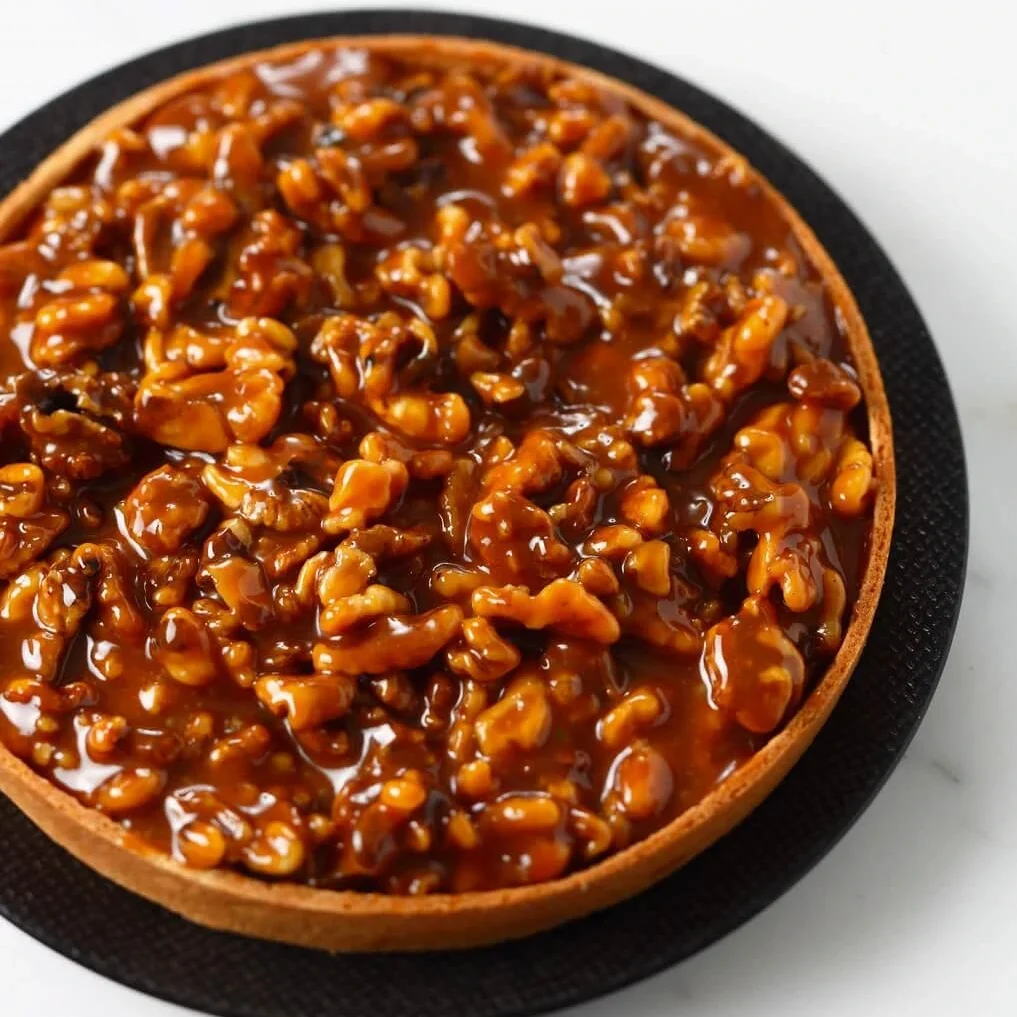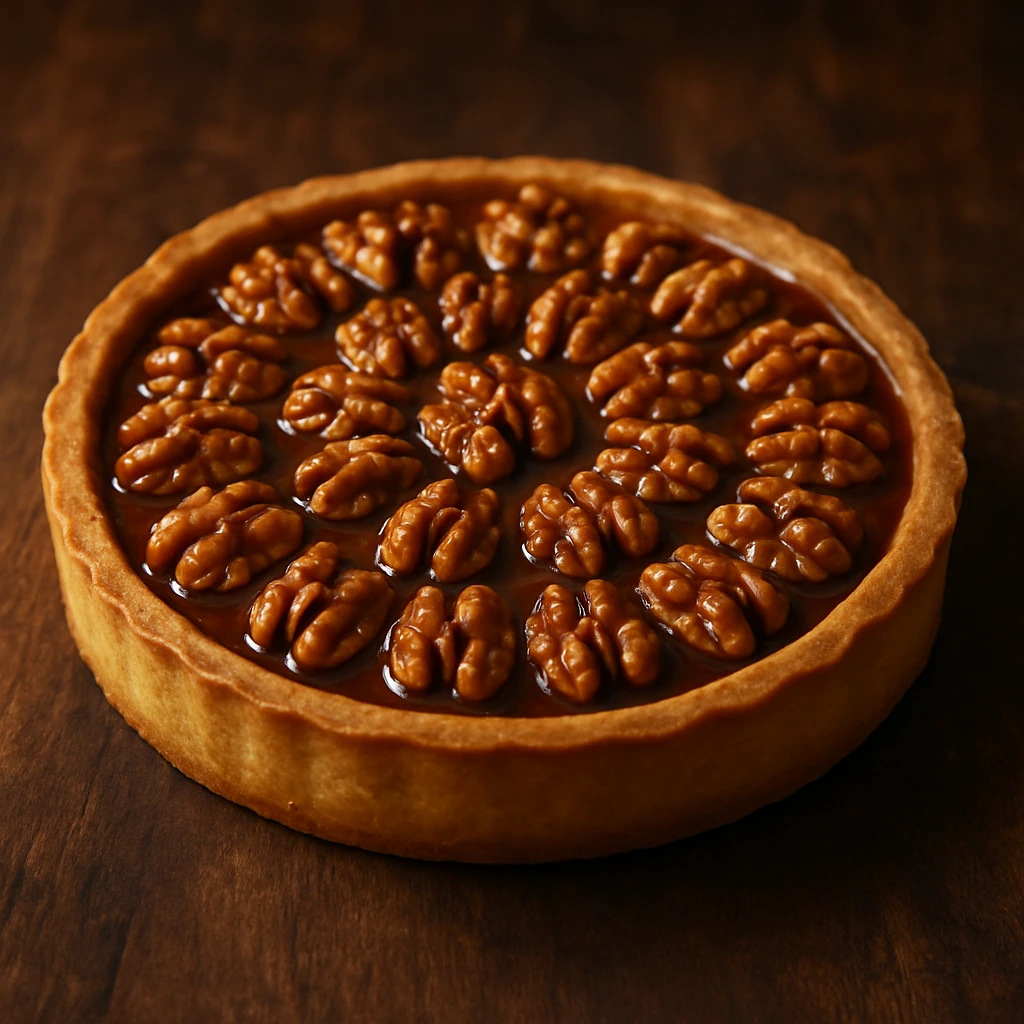The tarte aux noix is one of those understated jewels of French pâtisserie—rustic in its origin, yet refined in its final form. Hailing from the storied regions of southwestern France, especially the Périgord, where walnut groves stretch across the countryside, this tart is a true celebration of terroir and time-honored technique. With each slice, it offers a symphony of textures and flavors: the rich, buttery crust cradles a lusciously sweet filling that strikes a delicate balance between deep, nutty intensity and the comforting warmth of caramel or honeyed syrup.
Visually, the tart is both charming and indulgent. Often adorned with an elegant layer of glossy, golden walnuts nestled in a glistening glaze, it catches the light in a way that evokes both the golden tones of autumn and the refinement of a Parisian dessert table. While it may seem modest compared to more flamboyant French pastries, the walnut tart holds its own through sheer character—every bite tells a story of craftsmanship, patience, and respect for high-quality, seasonal produce.
What makes the tarte aux noix particularly unique is its dual identity: it’s just as much at home in a countryside inn as it is in a fine patisserie window. Served warm with a spoonful of crème fraîche or cold with a crisp coffee, it can be a rustic comfort or a sophisticated finish to a formal meal. It’s the kind of dessert that speaks not only to the palate but also to memory—invoking childhood visits to the bakery, long Sunday lunches, and the quiet joy of slicing into something made with care.
Making this tart at home is a joyful pursuit. It rewards attention to detail and invites the baker to work closely with texture and time, whether blind-baking a perfectly crisp crust or gently toasting walnuts to bring out their natural oils. Each step is part of a ritual that connects the baker to generations of French culinary tradition. And once it’s on the table—golden, fragrant, and irresistible—the walnut tart becomes more than a dessert. It becomes an experience, one rooted in history, shaped by the seasons, and meant to be shared.
Walnut Tart – Technical Sheet
Serves: 6
Timing
- Active Preparation: 35 minutes
- Chilling Time: 2 hours
- Freezing (tart shell): 20 minutes
- Baking Time: 30 minutes
- Storage: Keeps for up to 48 hours in the refrigerator
Recommended Equipment
- Stand mixer with paddle attachment
- Fine mesh sieve
- Rolling pin
- 22 cm (8.6 in) tart ring
- Perforated baking tray
- Baking parchment or Silpat mat
Ingredients
Sweet Pastry (Pâte Sucrée)
- 50 g unsalted butter
- 50 g icing sugar (confectioners’ sugar)
- 30 g egg (lightly beaten)
- 1 g fine sea salt
- 1 g liquid vanilla extract
- 125 g all-purpose flour
Walnut Caramel Filling
- 250 g walnut halves
- 50 g glucose syrup
- 250 g granulated sugar
- 175 g heavy cream (35% fat)
Method
Sweet Pastry
In the bowl of a stand mixer fitted with the paddle attachment, place the butter (cut into small cubes). Add the sifted icing sugar and mix on low speed until the mixture becomes pale and creamy.
In a separate bowl, whisk the salt and vanilla into the room-temperature egg until fully dissolved. Gradually add this mixture to the creamed butter, mixing until smooth and homogeneous.
Sift the flour, then add it to the bowl. Mix just until combined—avoid overworking the dough.
Transfer the dough to your work surface and perform a frasage (a gentle smearing motion using the palm of your hand) to finish bringing the dough together without developing gluten.
Shape into a flat disc, wrap in plastic wrap, and refrigerate for 1 hour.
Once chilled, roll out the dough and line a 22 cm tart ring. Freeze for 20 minutes before baking.
Blind bake in a preheated oven at 180°C (356°F / gas mark 4) for 15 to 20 minutes, or until the crust is lightly golden brown.
Walnut Caramel Filling
Spread the walnut halves evenly over a non-stick baking tray and toast them in the oven at 140–150°C (285–300°F / gas mark 5) for about 10 minutes, until fragrant and lightly colored.
In a saucepan, gently heat the glucose, then add the sugar. Cook without stirring until you achieve a deep amber caramel.
Carefully pour in the warm cream to deglaze the caramel (watch for steam and bubbling), then stir in the toasted walnuts. Mix well to coat the nuts evenly.
Assembly
Once the tart shell has fully cooled, fill it with the warm walnut caramel mixture, smoothing it gently into an even layer.
Refrigerate for at least 1 hour to allow the filling to set before serving.

Chef’s Tip
For a deeper, more complex flavor, lightly crush a small portion of the toasted walnuts before incorporating them into the caramel. This releases their natural oils and enhances the aromatic richness of the filling. You can also add a pinch of fleur de sel to the finished caramel while it’s still warm—this touch of salt beautifully balances the sweetness and intensifies the nuttiness.
Conclusion
There is something undeniably comforting—and quietly luxurious—about the classic French walnut tart. From its delicate sweet crust to its glossy, golden filling, this dessert speaks of time, care, and a respect for ingredients that have long held their place in French culinary heritage. It’s not a flashy dessert, but that is precisely its strength: it doesn’t need to impress with complexity. Instead, it seduces with balance—between crunch and creaminess, between sweet and savory, between rustic tradition and refined execution.
Baking a tarte aux noix at home is more than just following a recipe; it’s a ritual that invites you to slow down, toast the nuts with intention, watch the sugar darken into caramel, and build a dessert that tells a story. Whether you serve it at the end of a festive dinner, bring it to a gathering of friends, or simply enjoy a slice with your afternoon coffee, it brings with it a touch of French elegance and the quiet joy of handmade things.
So, as you let the caramel set and prepare to slice into that golden tart, know that you’re part of something timeless—a dessert that’s both humble and noble, made to be shared, savored, and remembered.
Q&A – All About Walnut Tart
Q: Can I make the tart shell in advance?
A: Absolutely. The sweet pastry can be prepared and refrigerated up to 48 hours in advance. You can also freeze the lined tart shell before baking to save time on the day of assembly.
Q: What can I use instead of glucose syrup?
A: While glucose gives the caramel extra shine and prevents crystallization, you can substitute it with light corn syrup or a small amount of honey. Just note that the flavor and texture may vary slightly.
Q: How do I prevent my caramel from becoming grainy?
A: Avoid stirring once the sugar begins to melt. If needed, gently swirl the pan. Adding glucose helps prevent crystallization. Also, always pour in the warm cream slowly to avoid shocking the caramel.
Q: Is it necessary to toast the walnuts?
A: Yes, it’s highly recommended. Toasting intensifies the flavor and ensures the nuts stay crunchy in the caramel. Ten minutes in the oven at a moderate temperature is all it takes.
Q: How should I serve this tart?
A: Serve chilled or at room temperature with a spoonful of crème fraîche or a dollop of lightly sweetened whipped cream. For a more decadent option, a scoop of vanilla ice cream makes a beautiful pairing.
Q: Can I freeze the finished tart?
A: It’s not ideal, as caramel can change texture when frozen. If you must, freeze the tart shell and prepare the filling fresh before serving.

